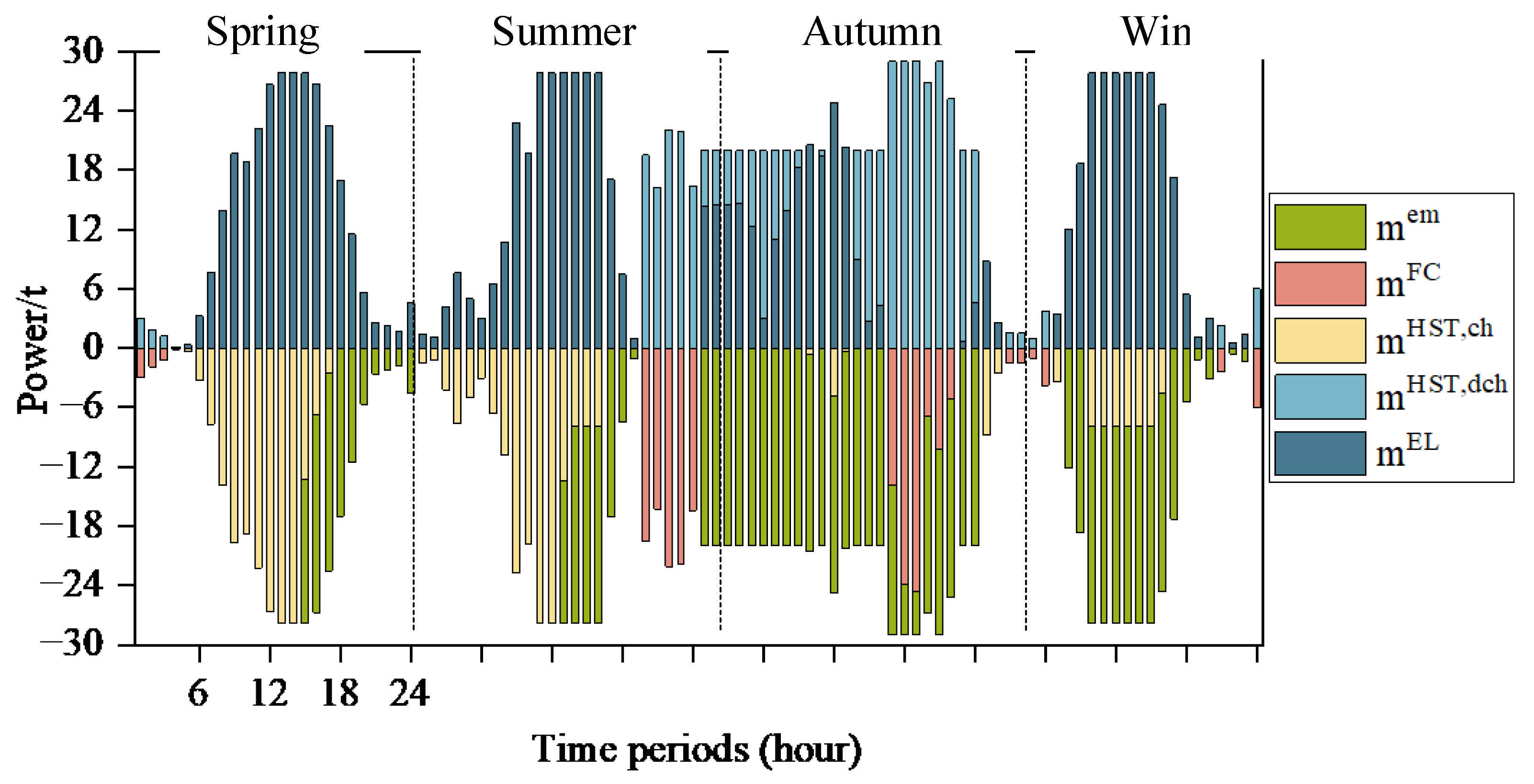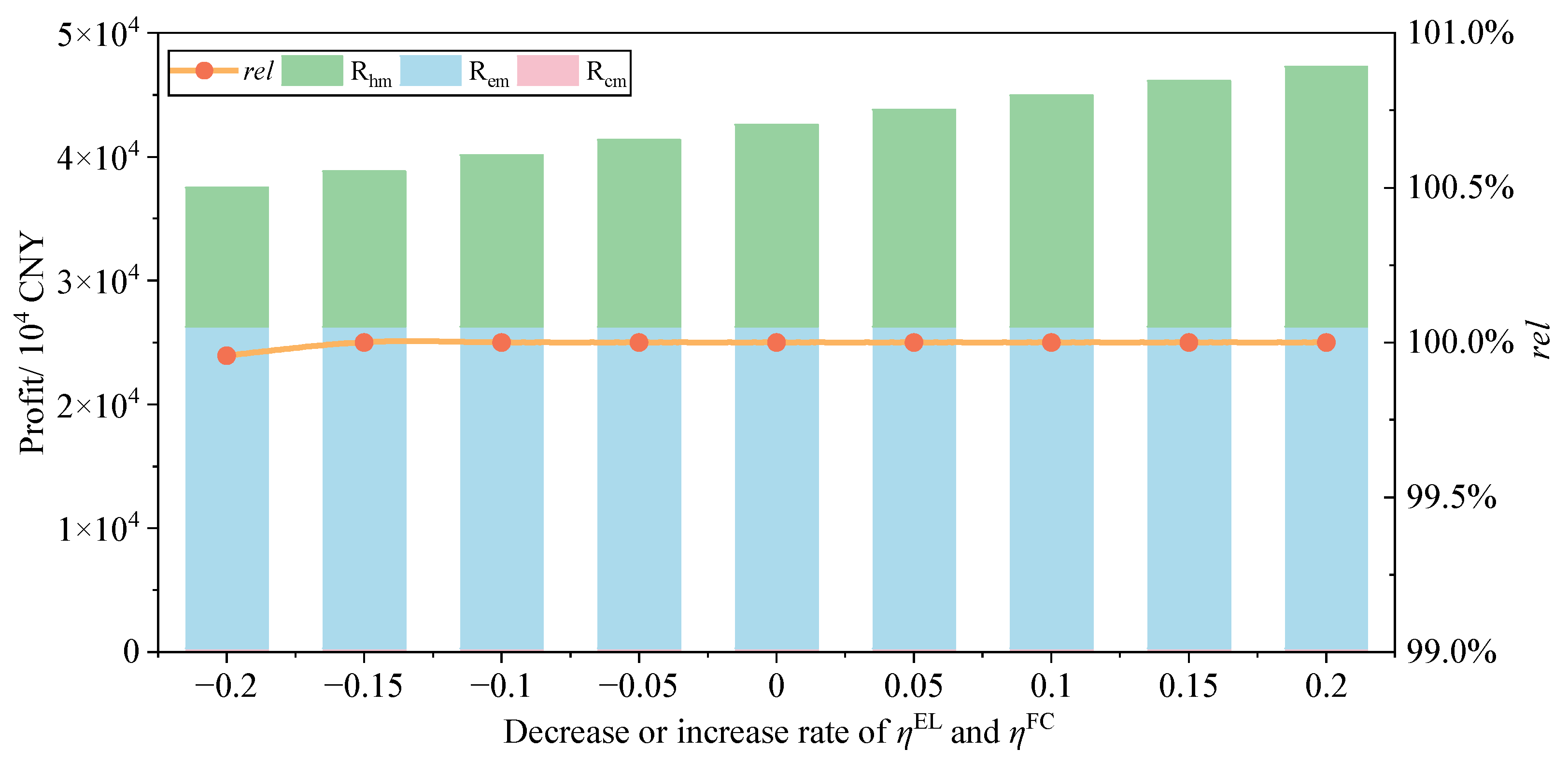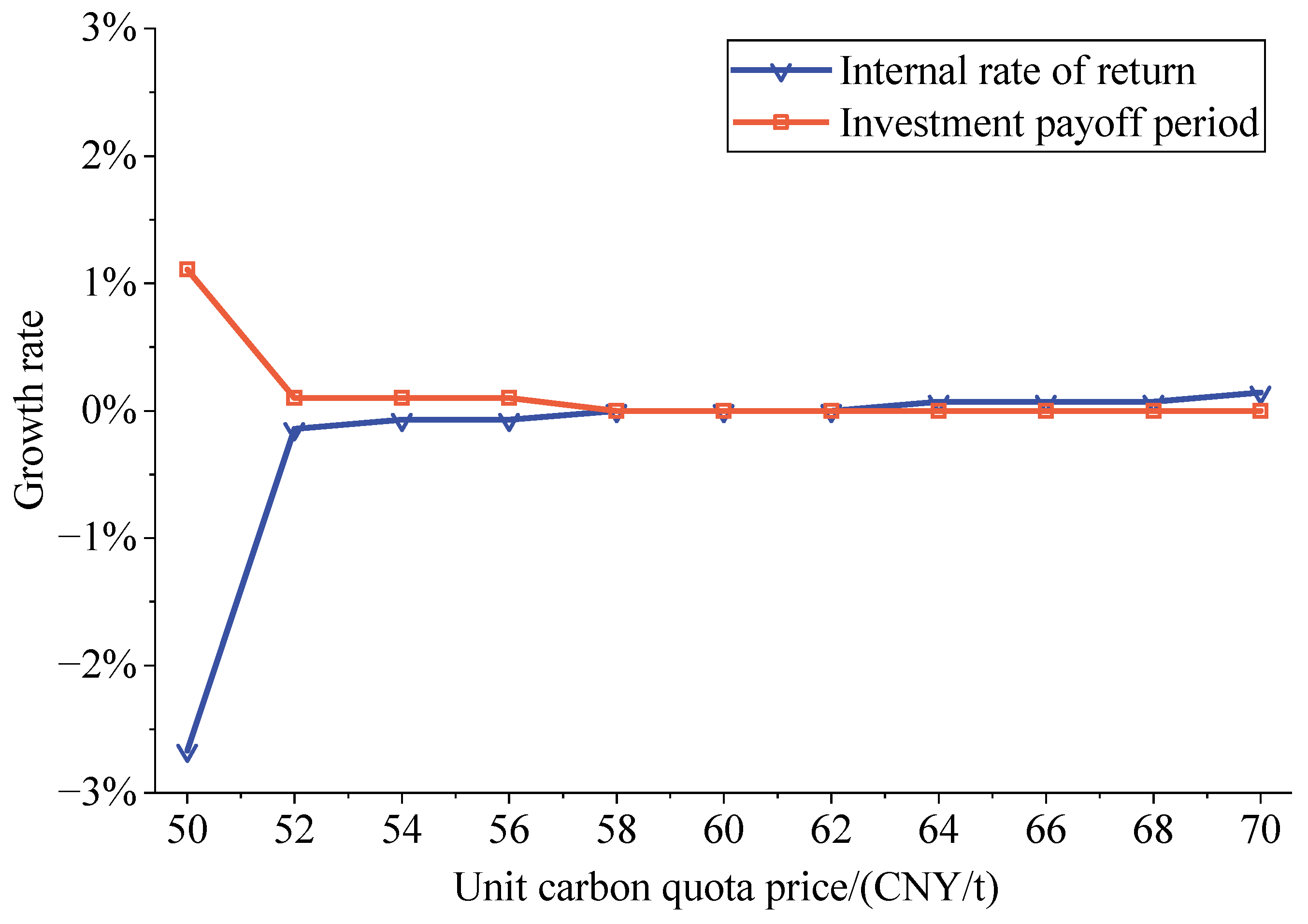Hydrogen-Involved Renewable Energy Base Planning in Desert and Gobi Regions Under Electricity-Carbon-Hydrogen Markets
Abstract
1. Introduction
2. The Structure of REB and Its Electricity-Carbon-Hydrogen Markets Transaction Model
2.1. The Structure of DG-REB Involving HES Introduction
2.2. Electricity-Carbon-Hydrogen Markets Transaction Model of DG-REB
3. Capacity Configuration Optimization Model for DG-REB
3.1. Model Construction
3.1.1. Objective Function
3.1.2. Constraints
3.2. Model Transformation and Solution
3.2.1. Nonlinear Model Transformation
3.2.2. Model Solution
4. Combination Scenario Generation Method Design Considering Extreme Scenario Optimization
5. Simulation
5.1. Parameter Setting
5.2. Analysis of Typical and Extreme Scenarios Generating
5.3. Analysis of Optimal Configuration Results
5.4. Operating Analysis of DG-REB Under Optimal Configuration Result
5.4.1. Capability Assurance Analysis of Renewable Energy Transmission
5.4.2. Effectiveness Analysis of Seasonal and Long-Term Transfer of HES
5.4.3. Short-Term Operation Analysis of DG-REB
5.5. Comparison Analysis
5.5.1. Comparison of Scenario Generation Method
5.5.2. Comparison of the REB
5.6. Sensitivity Analysis
5.6.1. Fluctuations in Electricity and Hydrogen Conversion Efficiency
5.6.2. Changes in Carbon Quota and Hydrogen Prices
6. Conclusions
- (1)
- The construction economics of the DG-REB stand within the industry’s reasonable range, and the DG-REB has sustainable operational capacity and development potential. Specifically, the total construction cost of the renewable energy base is CNY 2.61 × 1010, with a payback period of 10 years, an internal rate of return of 13.30% exceeding the annual interest rate of 4.9%, and a return on investment of 16.34%.
- (2)
- The introduction of hydrogen energy storage, on one hand, ensures that the DG-REB possess better economy and power supply reliability. Specifically, compared to traditional battery-involved DG-REBs, the HES-involved DG-REB achieves a 59.39% annual profit, a 10.98% internal rate of return, a 14.93% return on investment, and a 1.51% improvement in power supply reliability, despite incurring a 52.49% increase in construction cost.
- (3)
- The selected typical and extreme scenarios effectively support capacity configuration for DG-REBs. Compared to REB planning based only on typical scenarios, the power supply reliability of REBs based on the proposed combination scenario generation method improved by 8.58%.
Author Contributions
Funding
Data Availability Statement
Conflicts of Interest
Appendix A
References
- Tan, Q.; Siru, A.; Lang, W. Assessing local people’s perceptions of ecosystem services to support land management plans in arid desert regions, northwest China. Heliyon 2024, 10, e25302. [Google Scholar] [CrossRef]
- Tang, Y.; Liu, H.; Shu, H.; He, K.; Dai, Y.; Sun, W.; Wang, J.; Han, Y. Lightning induced electromagnetic crosstalk in wind–PV hybrid systems of the Gobi desert. Results Eng. 2025, 28, 107259. [Google Scholar] [CrossRef]
- Luo, N.; Zou, J.; Piao, X.; Khoo, H.L.; Jia, K.; Fan, J.; Wei, H.; Wang, Q.; Yan, X. Distinct Spatiotemporal Patterns and Meteorological Impacts of Gobi Desert and Taklimakan Desert Dust Storms over China. Environ. Technol. Innov. 2025, 40, 104393. [Google Scholar] [CrossRef]
- Renewable Power’s Growth is Being Turbocharged as Countries Seek to Strengthen Energy Security–News, IEA. Available online: https://www.iea.org/news/renewable-power-s-growth-is-being-turbocharged-as-countries-seek-to-strengthen-energy-security (accessed on 25 October 2023).
- Renewables-Energy System, IEA. Available online: https://www.iea.org/energy-system/renewables (accessed on 25 October 2023).
- Mehdi, M.; Ammari, N.; Merrouni, A.A.; el Galllassi, H.; Dahmani, M.; Ghennioui, A. An experimental comparative analysis of different PV technologies performance, including the influence of hot-arid climatic parameters: Toward a realistic yield assessment for desert locations. Renew. Energy 2023, 205, 695–716. [Google Scholar] [CrossRef]
- Available online: https://www.gov.cn/xinwen/2021-03/13/content_5592681.htm (accessed on 11 July 2025).
- Available online: https://www.ndrc.gov.cn/fggz/fzzlgh/gjfzgh/202112/t20211225_1309715.html (accessed on 11 July 2025).
- Si, L.; Wang, P.; Cao, D. Towards sustainable development goals: Assessment of wind and solar potential in northwest China. Environ. Res. 2024, 252, 118660. [Google Scholar] [CrossRef] [PubMed]
- Al Dawsari, S.; Anayi, F.; Packianather, M. Techno-economic analysis of hybrid renewable energy systems for cost reduction and reliability improvement using dwarf mongoose optimization algorithm. Energy 2024, 313, 133653. [Google Scholar] [CrossRef]
- Al-Dousari, A.; Al-Nassar, W.; Al-Hemoud, A.; Alsaleh, A.; Ramadan, A.; Al-Dousari, N.; Ahmed, M. Solar and wind energy: Challenges and solutions in desert regions. Energy 2019, 176, 184–194. [Google Scholar] [CrossRef]
- Liang, T.; Yang, J.; Chen, M.; Cao, X.; Tan, J.; Jing, Y.; Lv, L. Energy optimization scheduling of grid-connected renewable energy hydrogen production system based on RGHS-PPO algorithm. Renew. Energy 2025, 256, 124262. [Google Scholar] [CrossRef]
- Qin, J.; Fang, F.; Tian, X. Optimization configuration of hybrid energy storage capacities for large-scale renewable energy bases indesert: A case study of Tennger, China. Energy 2025, 332, 136791. [Google Scholar] [CrossRef]
- Chang, R.; Yan, Y.; Wu, J.; Wang, Y.; Gao, X. Projected PV plants in China’s Gobi Deserts would result in lower evaporation and wind. Sol. Energy 2023, 256, 140–150. [Google Scholar] [CrossRef]
- Liu, J.; Liu, Y. Capacity optimization configuration strategy for electrochemical-hydrogen hybrid energy storage based on state-of-charge self-recovery for wind power fluctuation smoothing. J. Power Sources 2025, 657, 238228. [Google Scholar] [CrossRef]
- Wang, Y.; Song, M.; Jia, M.; Shi, L.; Li, B. TimeGAN based distributionally robust optimization for biomass-photovoltaic-hydrogen scheduling under source-load-market uncertainties. Energy 2023, 284, 128589. [Google Scholar] [CrossRef]
- Wang, H.; Yuan, L.; Wang, W.; Song, M. Distributionally robust optimization for pumped storage power station capacity expanding based on underwater hydrogen storage introduction. Energy 2024, 310, 133254. [Google Scholar] [CrossRef]
- Papathanasiou, A.F.; Pasaniotis, G.; Baltas, E. Comparison of hydro-pumped and green hydrogen as energy storage processes: A case study on Kefalonia Island, Greece. Sustain. Chem. Pharm. 2025, 48, 102216. [Google Scholar] [CrossRef]
- Wang, C.; Deng, J.; Dibble, R.W.; Li, L. A novel hydrogen energy storage system: Power regeneration employing a 70% NITE Argon Power Cycle hydrogen-fueled engine. Int. J. Hydrogen Energy 2025, 178, 151531. [Google Scholar] [CrossRef]
- Sezer, N.; Bayhan, S. Solar-powered hybrid station with integrated liquid air and gaseous hydrogen energy storage for electric vehicle charging and hydrogen refueling. Int. J. Hydrogen Energy 2025, 173, 151338. [Google Scholar] [CrossRef]
- Liu, Z.; Ma, R.; Yu, X.; Yang, B. A capacity planning method for energy storage equipment of an integrated energy system including hydrogen storage, based on an oxygen sales mechanism. Int. J. Hydrogen Energy 2025, 177, 151535. [Google Scholar] [CrossRef]
- Wang, Y.; Song, M.; Jia, M.; Yang, B. Multi-objective distributionally robust optimization for hydrogen-involved total renewable energy CCHP planning under source-load uncertainties. Appl. Energy 2023, 342, 121212. [Google Scholar] [CrossRef]
- Habibifar, R.; Awad, A.S.A.; Azzouz, M.A. Planning energy hubs with hydrogen and battery storage for flexible ramping market participation. J. Energy Storage 2025, 140, 119012. [Google Scholar] [CrossRef]
- Wu, D.; Cai, G.; Ren, S.; Huang, Y. Optimal capacity planning for hydrogen-based urban multi-region energy systems: A comprehensive approach for long-term planning considering hourly demand balance. Int. J. Hydrogen Energy 2025, 177, 151429. [Google Scholar] [CrossRef]
- Wang, Y.; Tang, L.; Yang, Y.; Sun, W.; Zhao, H. A stochastic-robust coordinated optimization model for CCHP micro-grid considering multi-energy operation and power trading with electricity markets under uncertainties. Energy 2020, 198, 117273. [Google Scholar] [CrossRef]
- Sun, G.; Chen, G.; Liu, R.; Lin, S.; Wang, X. Dynamic reconfiguration of distribution network considering typical wind−Solar-Load joint scenarios. Int. J. Electr. Power Energy Syst. 2025, 172, 111121. [Google Scholar] [CrossRef]
- Niu, G.; Ji, Y.; Zhang, Z.; Wang, W.; Chen, J.; Yu, P. Clustering analysis of typical scenarios of island power supply system by using cohesive hierarchical clustering based K-Means clustering method. Energy Rep. 2021, 7, 250–256. [Google Scholar] [CrossRef]
- Tian, Z.; Wang, Y.; Li, X.; Wen, L.; Niu, J.; Lu, Y. Typical daily scenario extraction method based on key features to promote Building renewable energy system optimization efficiency. Renew. Energy 2024, 236, 121420. [Google Scholar] [CrossRef]
- Niño, M.; Amick, B.; Williams, M.; Norton-Smith, K.; Bingham, S. Extreme weather events, climate change attitudes, and preparedness on self-rated health and depressive symptoms. J. Clim. Change Health 2025, 26, 100582. [Google Scholar] [CrossRef]
- Shi, T.; Chen, H.; Liu, Y. Extreme temperatures and residential electricity reliability in China. Util. Policy 2025, 96, 102004. [Google Scholar] [CrossRef]
- Zhou, Y. Low-carbon urban–rural modern energy systems with energy resilience under climate change and extreme events in China—A state-of-the-art review. Energy Build. 2024, 321, 114661. [Google Scholar] [CrossRef]
- Karimi, A.; Norouzi, M.; Javanroodi, K. Solar chimney combined with active cooling systems for enhanced indoor comfort and energy efficiency under extreme climates: A data-driven optimization approach. Sol. Energy 2025, 300, 113809. [Google Scholar] [CrossRef]
- AbdelMeguid, H. Adaptive thermal buffering in solar desalination: Seasonally optimized PCM selection for extreme diurnal climates. Sol. Energy Mater. Sol. Cells 2025, 289, 113687. [Google Scholar] [CrossRef]
- Ju, H.; Li, X. Multi-objective optimization of phase change material radiant floor coupled ground source heat pump under future climate scenarios. Energy 2025, 333, 137338. [Google Scholar] [CrossRef]










| Parameters | Value | Parameters | Value |
|---|---|---|---|
| 4.5 × 106 CNY/MW | 500 CNY/MW | ||
| 2.4 × 107 CNY/each | 5/25/12 m/s | ||
| 2.2 × 106 CNY/MW | 5 MW | ||
| 5.3 × 106 CNY/MW | 1.8 × 10−7 MW/W | ||
| 1.2 × 106 CNY/MW | 6.434 × 103 m2/MW | ||
| 3.5 × 106 CNY/t | 0.022 | ||
| 0.7910 t/MWh | 9.09 | ||
| 0.7424 t/MWh | 0.99/0.99 | ||
| 0.078 t/MWh | 25 year | ||
| 0.2 | 4.9% | ||
| 0.02 |
| Parameter | Time Periods | Price | Unit |
|---|---|---|---|
| Peak period 8:00–11:00 16:00–19:00 | 1.10 × 103 | CNY/MWh | |
| Flat period 11:00–16:00 19:00–24:00 | 0.65 × 103 | CNY/MWh | |
| Valley period 0:00–8:00 | 0.35 × 103 | CNY/MWh | |
| All day | 2.5 × 104 | CNY/t | |
| All day | 60 | CNY/t |
| Equipment | Capacity | Unit |
|---|---|---|
| WT | 750 | MW |
| PV | 1800 | MW |
| TP | 300 | MW |
| EL | 1266 | MW |
| HFC | 251 | MW |
| HST | 2900 | t |
| Parameter | Value | Unit |
|---|---|---|
| Total construction cost | 2.61 × 1010 | CNY |
| Annual profit | 4.26 × 109 | CNY |
| Investment payoff period | 10 | Year |
| Internal rate of return | 13.30% | / |
| Return on Investment | 16.34% | / |
| Equipment | HES-Involved DG-REB | BT-Involved DG-REB | Unit |
|---|---|---|---|
| WT | 750 | 785 | MW |
| PV | 1800 | 2100 | MW |
| TP | 300 | 300 | MW |
| EL | 1266 | / | MW |
| HFC | 251 | / | MW |
| HST | 2900 | / | t |
| BT | / | 600 | MWh |
| Parameter | HES-Involved DG-REB | BT-Involved DG-REB | Unit |
|---|---|---|---|
| Total construction cost | 2.61 × 1010 | 1.24 × 1010 | CNY |
| Annual profit | 4.26 × 109 | 1.73 × 109 | CNY |
| Investment payoff period | 10 | 12 | Year |
| Internal rate of return | 13.30% | 11.84% | / |
| Return on Investment | 16.34% | 13.90% | / |
| HES-Involved DG-REB | BT-Involved DG-REB | |
|---|---|---|
| 100% | 98.49% |
| Equipment | Combination Scenario Generation Model | K-Medoids Algorithm Generation Model | Unit |
|---|---|---|---|
| WT | 750 | 750 | MW |
| PV | 1800 | 1800 | MW |
| TP | 300 | 300 | MW |
| EL | 1266 | 990 | MW |
| HFC | 251 | 220 | MW |
| HST | 2900 | 2100 | t |
| Parameter | Combination Scenario Generation Model | K-Medoids Algorithm Generation Model | Unit |
|---|---|---|---|
| Total construction cost | 2.61 × 1010 | 2.18 × 1010 | CNY |
| Annual profit | 4.26 × 109 | 4.20 × 109 | CNY |
| Investment payoff period | 10 | 9 | Year |
| Internal rate of return | 13.30% | 13.68% | / |
| Return on Investment | 16.34% | 18.38% | / |
| Combination Scenario Generation Model | K-Medoids Algorithm Generation Model | |
|---|---|---|
| 100% | 91.42% |
Disclaimer/Publisher’s Note: The statements, opinions and data contained in all publications are solely those of the individual author(s) and contributor(s) and not of MDPI and/or the editor(s). MDPI and/or the editor(s) disclaim responsibility for any injury to people or property resulting from any ideas, methods, instructions or products referred to in the content. |
© 2025 by the authors. Licensee MDPI, Basel, Switzerland. This article is an open access article distributed under the terms and conditions of the Creative Commons Attribution (CC BY) license (https://creativecommons.org/licenses/by/4.0/).
Share and Cite
Hu, J.; Ji, X.; Wang, H.; Feng, G.; Song, M. Hydrogen-Involved Renewable Energy Base Planning in Desert and Gobi Regions Under Electricity-Carbon-Hydrogen Markets. Processes 2025, 13, 3655. https://doi.org/10.3390/pr13113655
Hu J, Ji X, Wang H, Feng G, Song M. Hydrogen-Involved Renewable Energy Base Planning in Desert and Gobi Regions Under Electricity-Carbon-Hydrogen Markets. Processes. 2025; 13(11):3655. https://doi.org/10.3390/pr13113655
Chicago/Turabian StyleHu, Jiankun, Xiaoheng Ji, Haiji Wang, Guoping Feng, and Minghao Song. 2025. "Hydrogen-Involved Renewable Energy Base Planning in Desert and Gobi Regions Under Electricity-Carbon-Hydrogen Markets" Processes 13, no. 11: 3655. https://doi.org/10.3390/pr13113655
APA StyleHu, J., Ji, X., Wang, H., Feng, G., & Song, M. (2025). Hydrogen-Involved Renewable Energy Base Planning in Desert and Gobi Regions Under Electricity-Carbon-Hydrogen Markets. Processes, 13(11), 3655. https://doi.org/10.3390/pr13113655





